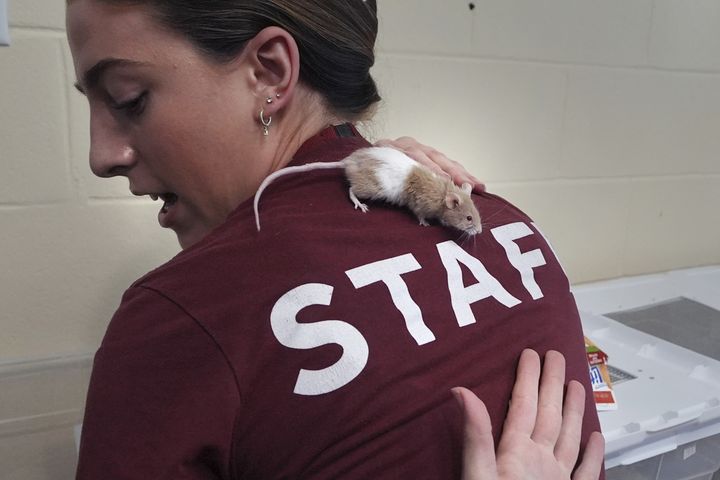Music
Trailers
DailyVideos
India
Pakistan
Afghanistan
Bangladesh
Srilanka
Nepal
Thailand
StockMarket
Business
Technology
Startup
Trending Videos
Coupons
Football
Search
Download App in Playstore
Download App
Best Collections
Technology
Drive.ai, the company thatgearing up to launch an autonomous ride-hailing pilot in Frisco, Texas, just released a video showing off its driverless capabilities. Drive.aiservice will initially launch with safety drivers in July, but the goal is to ultimately operate the ride-hailing platform without a driver behind the wheel.
In the video below, you can see a Drive.ai-powered car navigate both public and private roads without even a safety driver. On the lower-right-hand corner, you can see an augmented reality visualization that shows how the perception system works to identify cars, pedestrians, cyclists and other objects.
Before the July launch, Drive.ai will be collecting data along the routes and working with the city to educate people about self-driving technology. During this trial period, which starts in July and will run for six months, the service will be limited to employees, residents and patrons of Hall properties.Down the road, the goal is to open up the program to all residents of Frisco.
- Details
- Category: Technology
Read more: Watch a truly driverless car navigate city streets
Write comment (97 Comments)Welcome back to CTRL+T, the TechCrunch podcast where Megan Rose Dickey and I talk about the stories we want to talk about and connect them to the culture in which we&re all trying to live.
We first tackled the flying taxi phenomenon that isn&t really a phenomenon anymore. Itmore like we&re all going to be ducking under the near-distant hum of electric vertical take-off and landing vehicles, or eVTOLs (really rolls off the tongue), sooner than later. You see, Uber already has deals with flying taxi manufacturers, electric vehicle battery and charger manufacturers and firms that want to build the &skyports& from which these things are going to have to take off and land. And the public learned all about it at Uber Elevate.
But before we talked about Uber, we spent some time discussing the inside of Meganmouth. Regular readers might recall a recent visit she made to Uniform Teeth to find out about the startupfunding round. She tried out their 3D imaging tech and received some news she wasn&t quite prepared for. And recorded the audio.
Ita rip-roaring episode, folks, so click play below to have a listen. Or better yet, subscribe onApple Podcasts,Stitcher,Overcast,CastBoxor whatever other podcast platform you can find.
- Details
- Category: Technology
Read more: Uber’s plan to fly you around
Write comment (93 Comments)It seems Virginia is for tech lovers.
According to a report inThe Washington Post, Apple has been searching for places to put hubs as it contemplates how to spend the $30 billion it has committed for new facilities and 20,000 new employees in the U.S. over the next five years — and it looks like Virginia is on the list.
If Virginia makes the cut, Apple would be the second large tech company to call the state a (second or third) home, as Amazon is also reportedly looking at Virginia as a site for its second U.S. headquarters.
ThePostis reporting that Apple could seek to put up to 20,000 employees in a potential Northern Virginia campus that would total 4 million square feet of office space.
Citing conversations between the company and Virginia Governor Ralph Northam, thePost reported that state officials had proposed several sites for the Apple campus, which would be two-thirds the size of the Pentagon and half of what Amazon is looking for in its new HQ.
All of the attention from Amazon and Apple speaks to the new realty for tech companies, which is that Washington, DC has its eye on them… and, conversely, these companies need to have a closer eye on Washington.
Facebook and Google, which is owned by parent company Alphabet, have both also expanded their presence in the DC area. Four years ago, Google opened new offices in the capitalto much fanfare and ballyhoo, while Facebook plans to site a $1 billion data center in the Richmond area.
- Details
- Category: Technology
Read more: Apple reportedly looks to Virginia for another US campus
Write comment (100 Comments)Last week at UC BerkeleyZellerbach Hall, TechCrunch held its second TC Sessions: Robotics event. It was a full day of panels and demos, featuring the top minds in robotics, artificial intelligence and venture capital, along with some of the most cutting-edge demonstrations around.
If you weren&t able to attend, though, no worries; we&ve got the full event recorded for posterity, along with breakdowns of what you missed below.
Getting a Grip on Reality: Deep Learning and Robot Grasping
It turns out grasping objects is really hard for a robot. According to Ken Goldberg, professor and chair of the Industrial Engineering and Operations Research Department, itabout forces and torques. He and TechCrunch Editor-in-Chief Matthew Panzarino also discussed what Goldberg calls &fog robotics.& Goldberg differentiates it from &cloud robotics& in that &you don&t want to do everything in the cloud because of latency issues and bandwidth limitations, quality of service — and there are also very interesting issues about privacy and security with robotics.&
The Future of the Robot Operating System
Fetch Robotics CEO Melonee Wise joined fellow Willow Garage ex-patsBrian Gerkey and Morgan Quigley to discuss Open Robotics& Robot Operating System (ROS) efforts. The team is working to design and maintain an open and consistent framework for a broad range of different robotic systems.
Eyes, Ears, and Data: Robot Sensors and GPUs
Nvidia vice president Deepu Talla discussed how the chipmaker is making a central play in the AI and deep learning technologies that will drive robots, drones and autonomous vehicles of the future.
The Best Robots on Four Legs
Boston Dynamics CEO Marc Raibert announced onstage that the company66-pound SpotMini robot will be available for purchase by the normals in 2019. Yes, one day you, too, will be able to have a dog robot perform services for you at the office or home.
Old McDonald Needs a Robot
Agriculture is one of the next major fields for robotics, and we brought together some of the top startups in the field.Dan Steere of Abundant Robotics, Brandon Alexander of Iron Ox, Sébastien Boyer of FarmWise and Willy Pell of John Deere-owned Blue River Technology joined us onstage to discuss the ways in which robotics, artificial intelligence and autonomous systems will transform farm work in fields and orchards.
Teaching Robots New Tricks with AI
Pieter Abbeel is the Director ofthe UC Berkeley Robot Learning Lab and the co-founder of AI software company,covariant.ai. In a broad ranging discussion, Abbeel described the techniques his lab is using to teach robots how to better interact in human settings through repetition, simulation and learning from their own trial and error.
Can&t We All Just Get Along
Ayanna Howard of Georgia Tech, Leila Takayama of UC Santa Cruz and Patrick Sobalvarro of Veo Robotics took part in an exploration of the ways in which humans and robots can collaborate in work and home settings. Getting there is a mix of safety and education on both the humans& and robots& behalf.
Demos from 254 Lockdown, 1678 Citrus Circuit, Pi Competition: Hercules
Robotics teams from BellarmineCollegePreparatory, Davis High School and Hercules High School took to the stage before lunch time to show us what they have been working on. Each team built robots designed to tackle various tasks and the results are impressive.
Venture Investing in Robotics
Renata Quintini of Lux Capital, Rob Coneybeer of Shasta Ventures and Chris Evdemon of Sinovation Ventures all discussed the excitement around startups venturing into the robotics industry, but were also quite candid about the difficulty robotics founders face who are unfamiliar with a particular industry that they hope could reshape their innovation.
Betting Big on Robotics
Andy Rubin has had a lifelong fascination with robotics. In fact, it was his nickname during his time at Apple that gave the Android operating system its name. After a stint heading a robotics initiative at Google, Rubin is using his role as a co-founder of Playground Global to fund some of the most fascinating robotics startups around. In a one-on-one discussion, Rubin talked about why robotics are a good long- and short-term investment, and why one particular long-legged robot could be the future of package delivery.
From the Lab Bench to Term Sheet
This cute little robot fromMayfield Roboticscan blink, play music, turn its head and recharge itself. It can also just stay put to take pictures of you and live-stream your daily life. Yep. It watches you. Its name is Kuri and it can be your little buddy to always remind you that you never have to be alone.
Agility Robotics demonstration of Cassie
Agility Robotics&bipedal humanoid robot was designed with bird legs in mind. But it wasn&t yet designed with arms. The companyCTO Jonathan Hurst says those are to come. It&ll cost you $35,000 when itin full production mode. Custom deliveries started in August 2017 to a select few universities — University of Michigan, Harvard and Caltech, and Berkeley just bought its own. Although we didn&t see an example of this application, Cassie can apparently hold the body weight of a reasonably sized human.
Autonomous Systems
Safety has long been the focus of the push toward self-driving systems. Recent news stories, however, have cast a pall on the technology, leading many to suggest that companies have pushed to introduce it too quickly on public streets.Oliver Cameron of Voyage and Alex Rodrigues of Embark Trucks joined us to discuss these concerns and setbacks, as well as how the self-driving industry moves forward from here.
Teaching Intelligent Machines
Nvidia is working to help developers create robots and artificial intelligent systems. Vice president of Engineering Claire Delaunay discussed how the company is creating the tools to help democratize the creation of future robotics.
The Future of Transportation
Chris Urmson has been in the self-driving car game for a long time. He joined Googleself-driving car team in 2009, becoming head of the project four years later. These days, hethe CEO of Aurora, a startup that has logged a lot of hours testing its own self-driving tech on the roads. Urmson discussed the safety concerns around the technology and how far out we are from self-driving ubiquity.
Demos of RoMeLaNABi and ALPHRED
Humans are bipedal, so why is it so hard to replicate that in a robot, asks Dennis Hong, professor and founding director ofRoMeLa(Robotics - Mechanisms Library) of the Mechanical - Aerospace Engineering Department at UCLA. One of the reasons he said is because the distance between the left and right legs creates a twisting movement that renders forward and backward movement difficult. The resolution is to have them walk sideways. No twisting. So the team developed NABi (non-anthropomorphic biped), a bipedal locomotion robot with no &feet& or &shins.& To extend the admittedly limited functionality of NABi, the team then created ALPHRED (Autonomous Legged Personal Helper Robot with Enhanced Dynamics). ALPHREDlimbs, as the team calls them (¬ legs, not arms&), form to create multimodal locomotion, because of its multiple types of formations.
Building Stronger Humans
The BackX, LegX and ShoulderX from SuitX serve to minimize the stress we humans tend to place on our joints. We saw the application of these modules onstage.But infinitely more impressive during the conversation with company co-founder Homayoon Kazerooni was the application the audience saw of the companyexoskeleton. Arash Bayatmakou fell from a balcony in 2012, which resulted in paralysis. He was told he would never walk again. Five years later, Arash connected with SuitX, and he has been working with a physical therapist to use the device to perform four functions: stand, sit and walk forward and backward. You can follow his recoveryhere.
- Details
- Category: Technology
Read more: Watch every panel from TC Sessions: Robotics
Write comment (98 Comments)Compound wants to let you borrow cryptocurrency, or lend it and earn an interest rate.Most cryptocurrency is shoved in a wallet or metaphorically hidden under a mattress, failing to generate interest the way traditionally banked assets do. But Compound wants to create liquid money markets for cryptocurrency by algorithmically setting interest rates, and letting you gamble by borrowing and then short-selling coins you think will sink. It plans to launch its first five for Ether, a stable coin, and a few others, by October.
Today, Compound is announcing some ridiculously powerful allies for that quest. Itjust become the first-ever investment by crypto exchange juggernaut Coinbase new venture fund. Itpart of an $8.2 million seed round led by top-tier VC Andreessen Horowitz, crypto hedge fund Polychain Capital and Bain Capital Ventures — the startup arm of the big investment firm. [Update: Compound told us it was Coinbase Ventures& first investment when it closed its round, though Coinbase notes that itdone 8 rapid-fire investments over the past two months alongside this funding.]
While right now Compound deals in cryptocurrency through the Ethereum blockchain, co-founder and CEO Robert Leshner says that eventually he wants to carry tokenized versions of real-world assets like the dollar, yen, euro or Google stock. Thatbecause Leshner tells me &My thesis is that almost every crypto asset is bullshit and not worth anything.&
How to get Compound interest on your crypto
Herehow Compound tells me itgoing to work. Itan &overnight& market that permits super-short-term lending.While itnot a bank, it is centralized, so you loan to and borrow from it directly instead of through peers, alleviating you from negotiation.If you loan, you can earn interest. If you borrow, you have to put up 100 percent of the value of your borrow in an asset Compound supports. If prices fluctuate and your borrow becomes worth more than your collateral, some of your collateral is liquidated through a repo agreement so they&re equal.
To set the interest rate, Compound acts kind of like the Fed. Itanalyzes supply and demand for a particular crypto asset to set a fluctuating interest rate that adjusts as market conditions change. You&ll earn that on what you lend constantly, and can pull out your assets at any time with just a 15-second lag. You&ll pay that rate when you borrow. And Compound takes a 10 percent cut of what lenders earn in interest. For crypto-haters, it offers a way to short coins you&re convinced are doomed.
&Eventually our goal is to hand-off responsibility [for setting the interest rate] to the community. In the short-term we&re forced to be responsible.Long-term we want the community to elect the Fed,& says Leshner. If it gets the interest rate wrong, an influx of lenders or borrowers will drive it back to where itsupposed to be. Compound already has a user interface prototyped internally, and it looked slick and solid to me.
&We think ita game changer. Ninety percent of assets are sitting in peoplecold storage, or wallets, or exchanges. They aren&t being used or traded,& says Leshner. Compound could let people interact with crypto in a whole new way.
The Compound creation story
Compound is actually the third company Leshner and his co-founder and CTO Geoff Hayes have started together. They&ve been teamed up for 11 years since going to college at UPenn. One of their last companies, Britches, created an index of CPG inventory at local stores and eventually got acquired by Postmates. But before that Leshner got into the banking and wealth management business, becoming a certified public accountant. A true economics nerd, hethe chair of the SF bond oversight committee, and got into crypto five years ago.
Compound co-founder and CEO Robert Leshner
Sitting on coins, Leshner wondered, &Why can&t I realize the time value of the cryptocurrency I possess& Compound was born in mid-2017, and came out of stealth in January.
Now with $8.2 million in funding that also came fromTransmedia Capital, Compound Ventures, Abstract Ventures and Danhua Capital, Compound is pushing to build out its product and partnerships, and &hire like crazy& beyond its seven current team members based in San FranciscoMission District. Partners will be crucial to solve the chicken-and-egg problem of getting its first lenders and borrowers. &We are planning to launch with great partners — token projects, hedge funds and dedicated users,& says Leshner. Having hedge funds like Polychain should help.
&We shunned an ICO. We said, ‘letraise venture capital.& I&m a very skeptical person and I think most ICOs are illegal,& Leshner notes. The round was just about to close when Coinbase announced Coinbase Ventures. So Leshner fired off an email asking if it wanted to join. &In 12 hours they researched us, met our team, diligenced it and evaluated it more than almost any investor had to date,& Leshner recalls. Asked if thereany conflict of interest given Coinbasegrand ambitions, he said, &They&reprobably our favorite company in the world. I hope they survive for 100 years. Ittoo early to tell they overlap.&
Conquering the money markets
There are other crypto lending platforms, but none quite like Compound. Centralized exchanges like Bitfinex and Poloniex let people trade on margin and speculate more aggressively. But they&re off-chain, while Leshner says Compound is on-chain, transparent and can be built on top of. That could make it a more critical piece of the blockchain finance stack. Therealso a risk of these exchanges getting hacked and your coins getting stolen.
Meanwhile, there are plenty of peer-to-peer crypto lending protocols on the Ethereum blockchain, like ETHLend and Dharma. But interest rates, no need for slow matching, flexibility for withdrawing money and dealing with a centralized party could attract users to Compound.
Still, the biggest looming threat for Compound is regulation. But to date, the SEC and regulators have focused on ICOs and how people fundraise, not on what people are building. People aren&t filing lawsuits against actual products. &All the operations have flown beneath the radar and I think thatgoing to change in the next 12 months,& Leshner predicts. How exactly they&ll treat Compound is up in the air.
One source in the crypto hedge fund space told me about forthcoming regulation: &You&re either going to get annihilated and have to disgorge profits or dissolve. Or you pay a fine and you&re among the first legal funds in the space. This is the gamble you take before asset classes get baptized.& As Leshner confirmed, &Thatthe number one risk, period.&
Money markets are just one piece of the financial infrastructure puzzle that still needs to emerge around blockchain. Custodians, auditors, administrators and banks are still largely missing. When those get hammered out to make the space safer, the big money hedge funds and investment banks could join in. For Compound, getting the logistics right will require some serious legal ballet.
Yet Leshner is happy to dream big despite all of the crypto worldvolatility. He concludes, &We want to be like Black Rock with a trillion under management, and we want to have 25 employees when we do that.They probably have [tens of thousands] of employees. Our goal is to be like them with a skeleton team.&
- Details
- Category: Technology
Read more: Coinbase’s first investment, Compound, earns you interest on crypto
Write comment (96 Comments)Coinbase has come a long way since its launch in 2012. The company has raised more than $225 million and paved the way for cryptocurrencies to enter the mainstream by providing a digital currency exchange. Which is why we&re absolutely thrilled to have Coinbase co-founder and CEO Brian Armstrong join us on the main stage at TechCrunch Disrupt SF in September.
Armstrong worked as a developer for IBM and consultant at Deloitte before joining Airbnb as a software engineer in 2011. At Airbnb, Armstrong focused on fraud prevention, giving him the opportunity to learn about payment systems across the 190 countries Airbnb serves.
In 2012, Armstrong co-founded Coinbase and gave a budding demographic of cryptocurrency enthusiasts the opportunity to trade in their USD for bitcoins, and later the digital currency of their choice. Coinbase currently serves over 10 million customers across 32 countries, providing custody for more than $10 billion in digital assets.
In fact, Coinbase was valued at $1.6 billion following a $100 million funding round in August 2017.
In April, the company unveiled an early-stage fund for cryptocurrency startups, and acquired Earn.com for $100 million. As part of the acquisition, the company brought on Balaji Srinivasan as its first CTO.
There were also reports that Coinbase approached the SEC to become a licensed brokerage firm and electronic trading venue, which would allow the company to expand beyond the four coins (Bitcoin, Bitcoin Cash, Ethereum, Litecoin) that trade on the platform now.
Just yesterday, Coinbase announced that it would offer a new suite of services aimed at institutional investors, who are beginning to warm up to cryptocurrencies.
There is plenty to discuss with Armstrong come September, and we&re absolutely thrilled to have him join the stellar Disrupt SF agenda. You can head over here to buy yourself tickets. See you there!
- Details
- Category: Technology
Read more: Coinbase CEO Brian Armstrong to talk the future of cryptocurrency at Disrupt SF
Write comment (100 Comments)Page 5364 of 5614

 7
7










